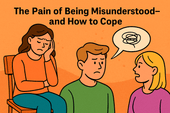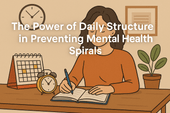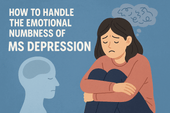Facing Invisible Symptoms: How to Get Validation and Be Taken Seriously
When you live with Multiple Sclerosis (MS), not all symptoms are visible. And yet, they’re very real.
💥 Crushing fatigue
💫 Brain fog
⚡ Nerve pain
😣 Bladder urgency
🌫️ Vision changes
😔 Emotional lability
These invisible symptoms often don’t show up on the outside — which means people may question, ignore, or dismiss them.
This article explores how to:
- 🧭 Navigate the emotional toll of invisible symptoms
- 🗣️ Advocate for yourself with healthcare providers and loved ones
- 🙋Communicate your needs without shame
- 💬 Respond to invalidation (without losing your cool)
- 🤝 Build a circle of people who take you seriously
- ✨ Validate yourself — even when no one else does
If you’ve ever heard “But you look fine!” — this article is for you.
Looking for an online therapist? Click here.
👻 What Are “Invisible” MS Symptoms?
Invisible symptoms are those that affect your daily life and well-being but are not immediately visible to others.
Here are some of the most common ones in MS:
| Symptom | How It Feels |
|---|---|
| Fatigue | Like your body is made of cement, despite rest |
| Cognitive changes | Forgetting words, confusion, brain fog |
| Pain or numbness | Burning, stabbing, tingling, without cause |
| Bladder urgency | Needing to go NOW — even if the bathroom's far |
| Anxiety or depression | Emotional swings, sadness, irritability |
| Vertigo or dizziness | Feeling like the floor is moving beneath you |
| Sensory overload | Noise or light making your head feel like it’s exploding |
These symptoms may not show up on MRI scans, tests, or even during doctor's appointments. But they can crush your confidence, energy, and relationships.
😞 The Emotional Toll of Not Being Believed

When your pain is invisible, you often face:
- 🚫 Doubt from doctors
- 🤷Dismissiveness from employers
- 👩❤️👨 Frustration from family
- 🧠 Internalized shame (“Maybe I’m overreacting?”)
This invalidation is painful. It creates medical trauma and fuels self-doubt.
You start asking:
“Is it really that bad?”
“Maybe I should just push through.”
“I don’t want to sound like I’m complaining.”
But silence comes at a cost. You suffer alone. And that’s not okay.
🧭 Step 1: Validate Yourself First
Before you demand understanding from others, start with self-validation. This builds your confidence and prepares you to advocate for yourself.
✨ How to validate your own experience:
- Keep a symptom journal. Write how you feel physically and emotionally. Track patterns.
- Say to yourself:
“Just because others can’t see it doesn’t mean it’s not real.”
- Use anchoring phrases like:
“My experience is valid.”
“I don’t need proof to deserve support.”
Self-validation is the foundation of self-advocacy.
🧑⚕️ Step 2: Get Your Healthcare Team on Your Side

Doctors can’t treat what they don’t understand. And unfortunately, some dismiss invisible symptoms as “stress” or “anxiety.”
🩺 Tips for being taken seriously by your doctor:
1. 📋 Bring Documentation
- Symptom tracker apps or written logs
- Photos or videos (if relevant, e.g., balance issues)
- List of questions and flare patterns
2. 🧠 Use Specific Language
Instead of “I’m tired,” try:
“It feels like my muscles are shutting down after 5 minutes of walking.”
Instead of “brain fog,” say:
“I lose words mid-sentence and forget conversations.”
3. 🙋Ask to Be Heard
Say this early in your appointment:
“I know my symptoms aren’t visible, but they are deeply affecting my life. I’d really appreciate your support in exploring what could help.”
4. 🔄 Don’t Be Afraid to Switch Providers
You deserve a neurologist or GP who listens, respects, and believes you. If your current doctor isn’t responsive, seek a second opinion.
👪 Step 3: Talk to Family and Friends (Even When It’s Hard)
Sometimes, the people closest to you are the least understanding. They don’t mean harm — but their confusion can feel like betrayal.
🙋 How to explain invisible symptoms to loved ones:
✅ Choose a calm moment
Don’t wait until you’re in pain. Share on a “neutral” day.
✅ Use analogies they understand:
“It’s like running a marathon with the flu — but inside my body, every day.”
“My battery drains faster than yours. I’m not lazy — I’m low on fuel.”
✅ Set clear boundaries:
“I need you to trust that what I say I feel, I really feel. I’m not exaggerating or being dramatic.”
🛑 Step 4: Stop Justifying Your Pain
You do not need to prove:
- How bad it is
- How long it’s been happening
- That you’re doing your best
- That you’re not exaggerating
You are not a case to be argued — you are a person to be cared for.
When someone doesn’t understand, calmly say:
“I’m not here to convince you. I’m here to be honest.”
💬 Step 5: Prepare Responses to Invalidating Comments
You’ve probably heard these:
- “But you don’t look sick.”
- “We all get tired.”
- “Have you tried yoga/green juice/thinking positively?”
- “You’re just stressed.”
- “You were fine yesterday!”
🔁 Try these calm but firm replies:
| Invalidating Comment | Empowered Response |
|---|---|
| "You look fine!" | "Thanks. MS symptoms aren’t always visible." |
| "Everyone gets tired." | "True, but MS fatigue is medical — not just tiredness." |
| "It’s all in your head." | "It’s in my nervous system, actually. And it’s real." |
| "You were okay yesterday." | "MS symptoms fluctuate. That’s part of the condition." |
You’re not being defensive — you’re educating. And you don’t owe anyone a detailed explanation.
🤝 Step 6: Find a Validation-Ready Community
There are thousands of people walking this same path. Find them.
🧑🤝🧑 Where to go for understanding:
- Instagram: Look for MS advocates and spoonie creators
- Reddit: r/MultipleSclerosis
- Facebook Groups: "MS Support Circle," "Living with MS (Unfiltered)"
- Discord Servers: Many chronic illness servers welcome MS folks
- MyMSTeam.com and Shift.ms offer peer support
- Local MS Society meetups or online Zoom chats
In the right space, you’ll hear:
“I know exactly what you mean.”
“That happens to me too.”
“You’re not crazy — you’re valid.”
That changes everything.
🧘Step 7: Learn to Rest Without Guilt

When invisible symptoms flare, your first instinct may be to hide it, push through, or apologize.
Instead, try this:
- Rest openly. No shame.
- Ask for help. Clearly and kindly.
- Say no. Without justifying.
Rest is not giving up. It’s resisting a system that values productivity over people.
✨ Bonus: Self-Compassion Is a Superpower
Dr. Kristin Neff, an expert in self-compassion, teaches that being kind to yourself actually builds resilience — especially when you feel misunderstood.
Try these affirmations:
“I am allowed to struggle without being questioned.”
“What I feel matters, even when it’s invisible.”
“I will treat myself the way I wish others treated me.”
Speak to yourself like someone worth believing — because you are.
💬 Real Voices from the MS Community
“My pain wasn’t visible, so I was labeled ‘dramatic.’ I kept it quiet for years. Finding people who understood was life-changing.”
— Lila, 33
“My neurologist said, ‘Fatigue is just part of life.’ I changed doctors. My new one actually listens. I finally feel human again.”
— Marcus, 46
“I used to cry because no one believed my brain fog was real. Now I keep a little journal and bring it to every appointment. They take me more seriously now.”
— Ana, 29
❤️ Final Thoughts: You Deserve to Be Heard
Your invisible symptoms are real. Your experience is valid. You deserve:
- To be believed
- To be supported
- To rest without guilt
- To receive compassionate care
- To live with dignity, not doubt
If you’re facing disbelief, don’t shrink. Speak. Educate. Document. Connect. Advocate. Rest. Repeat.
You are not alone. You are not making it up.
And you are absolutely worth taking seriously.
Looking for an online therapist? Click here.
Related Posts
-

Learning to Feel Safe in Your Body Again
If your body no longer feels like a safe place—due to trauma, chronic illness, or anxiety—you’re not alone. This guide offers gentle, body-based strategies to help you reconnect with yourself, regulate your nervous system, and rebuild trust in your physical experience.
-

When You Feel Emotionally Unlovable: Challenging the Lie
Feeling unlovable because of your emotions, illness, or sensitivity? You’re not broken—you’re healing. Learn how to challenge the lie of emotional unworthiness and rebuild self-trust, one compassionate step at a time.
-

Brain Fog and Fatigue: How to Stop Blaming Yourself
Struggling with brain fog or chronic fatigue? You’re not lazy or failing. Learn how to stop blaming yourself for symptoms caused by MS or chronic illness, and start embracing a more compassionate path to healing and self-understanding.
-

Creating an Emotional Support Team You Actually Trust
Tired of feeling unsupported or misunderstood? Learn how to build an emotional support team you actually trust—with people who see you, hold space for you, and respect your boundaries, especially when living with MS or chronic illness.
-

MS, Vulnerability, and the Fear of Being Seen
Living with MS can make vulnerability feel unsafe. Learn why so many people with MS hide their struggles—and how to gently move toward authenticity, self-acceptance, and deeper connection without shame.
-

Mindful Transitions Between Rest and Action
Struggling to shift between rest and activity without guilt or overwhelm? This guide offers gentle, mindful strategies to make transitions feel more natural, intentional, and supportive of your nervous system.
-

The Pain of Being Misunderstood—And How to Cope
Feeling the sting of being misunderstood? Learn why it hurts so deeply and discover practical, healing strategies to protect your truth, communicate clearly, and rebuild emotional safety when others just don’t get it.
-

Letting Go of Productivity Guilt When You Need to Rest
Struggling with guilt every time you try to rest? Learn how to release productivity shame, understand why rest matters, and embrace a more compassionate rhythm for healing and recovery—without feeling lazy.
-

Rebuilding Energy Reserves Without Shame
-

What to Do If You Feel Emotionally Invalidated by Doctors
Feeling emotionally invalidated by your doctor can be deeply distressing. Learn how to recognize medical gaslighting, validate your own experience, and advocate for better care when you’re not being heard.
-

How to Rest Without Feeling Lazy
Rest isn’t laziness—it’s a necessary act of self-respect. Learn how to shift your mindset, let go of guilt, and embrace rest as a vital part of mental and physical well-being.
-

Redefining Energy Management as Emotional Self-Care
Energy isn’t just physical—it’s emotional. Learn how redefining energy management as emotional self-care can help you protect your peace, support your nervous system, and live more in tune with your true needs.
-

Sleep Deprivation and Emotional Dysregulation in MS
-

How to Cope When Friends Disappear After Diagnosis
Losing friends after a diagnosis can feel like another kind of grief. Discover why some friends disappear—and how to cope with the emotional fallout while building more supportive relationships.
-

How to Talk to Your Kids About MS Without Overwhelming Them
Struggling with how to explain MS to your kids? Learn how to talk to children of all ages about multiple sclerosis with honesty, clarity, and emotional safety—without overwhelming them.
-

MS and the Fear of Emotional Abandonment
The fear of emotional abandonment is common for people with MS. This article explores why it happens, how it impacts your relationships, and how to create emotional safety and healing.
-

Forgiveness, Closure, and Letting Go of the Past with MS
Living with MS often brings emotional wounds from the past. Learn how forgiveness, closure, and letting go can help you heal emotionally—and reclaim peace in the present.
-

Supplements and Habits That Support Sleep and Emotional Balance
Struggling with poor sleep and emotional ups and downs? Discover calming supplements and daily habits that support deep rest and mental well-being—backed by science and easy to implement.
-

When Insomnia Feels Like Your MS Brain Won’t Turn Off
Struggling to sleep with MS? When your brain won’t shut off at night, insomnia feels relentless. Learn what causes it—and discover science-backed strategies to calm your mind and finally rest.
-

The Emotional Toll of Waking Up Tired Every Day: Why It Hurts More Than You Think
Waking up tired every day takes a deep emotional toll—from mood swings to lost motivation and self-doubt. Learn why chronic fatigue hurts more than you think and how to gently reclaim your mornings.
-

Bedtime Anxiety and MS: How to Break the Cycle
Bedtime anxiety is a common struggle for people with MS—and it’s more than just racing thoughts. Learn how MS-related stress, nervous system dysregulation, and fear of symptoms can create a cycle of sleeplessness, and discover practical, calming strategies to finally reclaim restful nights.
-

How Mental Health Affects Sleep Quality in MS: Breaking the Cycle of Fatigue and Emotional Distress
Struggling to sleep when you have MS? Discover how anxiety, depression, and neurological changes impact your rest—and what you can do to reclaim it. From CBT-I and calming supplements to lifestyle tips that support both mental health and sleep, this guide offers practical strategies for better nights.
-

Learning to Love Your Life (Even When It’s Not What You Expected)
Your life may not look how you imagined—but it’s still worth loving. Learn how to find peace, purpose, and joy in the unexpected.
-

Tips for Managing Depressive Thoughts Without Judgment
Learn how to meet depressive thoughts with compassion, not shame. These gentle, research-backed tools help you manage low moods without self-judgment.
-

Rewiring Hope: How to Slowly Come Back to Life
Feeling emotionally numb or disconnected? Learn how to gently rebuild hope, one small sensory step and spark of life at a time.
-

Depression and Suicidality in MS: A Conversation That Needs to Happen
Depression and suicidality in MS are real—and urgent. Learn why we must talk about it, how to spot warning signs, and where to find help and hope.
-

Finding Meaning When Life Feels Empty
Feeling disconnected or numb? Discover gentle ways to find meaning again—even in emptiness—through daily rituals, reflection, and purpose.
-

The Power of Daily Structure in Preventing Mental Health Spirals
Daily structure can prevent mental health spirals by creating safety, routine, and self-trust—especially for those with MS, depression, or anxiety.
-

Healing from Emotional Flatness with Sensory Rituals
Feeling emotionally numb or disconnected? Discover how sensory rituals can gently restore pleasure, presence, and emotional resilience.
-

The Role of Light Therapy for Seasonal Depression and MS
Can light therapy ease seasonal depression in people with MS? Discover the science, benefits, and how to use it safely for better mood and energy.
-

Medication vs Therapy: Treating MS-Related Depression Effectively
Explore whether therapy, medication, or both are best for treating MS-related depression. Understand what works, when—and why combination care is often ideal.
-

How to Support a Partner with MS and Depression
Learn how to support a partner living with MS and depression—practical tips, emotional tools, and ways to protect your own mental health too.
-

The Emotional Cost of Losing Your Old Life
Losing your old life to MS isn’t just about physical symptoms—it’s about grieving the identity, dreams, and freedom you once had. This article explores the emotional toll of invisible grief and how to begin healing without denying the pain.
-

MS, Depression, and Hormones: What You Should Know
MS-related depression isn’t always just emotional—it can be hormonal. Discover how thyroid, sex, and stress hormones influence mood in MS, why women may feel worse during PMS or menopause, and what signs to look for when hormones may be driving emotional instability.
-

MS and Anhedonia: Reclaiming Pleasure One Step at a Time
Anhedonia—feeling emotionally flat or disconnected—is a common but misunderstood symptom of MS depression. This article explores how neuroinflammation, dopamine disruption, and fatigue can dull your sense of joy—and how small, gentle steps can help you begin to feel again.
-

How to Handle the Emotional Numbness of MS Depression
Emotional numbness in MS depression doesn’t always look like sadness—it can feel like nothing at all. Learn why this disconnection happens, how it's tied to neuroinflammation and nervous system overload, and discover science-backed strategies to gently reconnect with your emotions.
-

How Inflammation Can Affect Mood in MS
Mood swings and emotional numbness in MS aren’t just psychological—they can be driven by immune system inflammation. This article explores how inflammatory cytokines affect the brain, why mood changes are often biological, and what you can do to calm your nervous system from the inside out.
-

Recognizing Depression in MS: It's Not Just Sadness
Depression in multiple sclerosis (MS) is more than just sadness—it can be a neurological symptom, a side effect of inflammation, or a silent weight that masks itself as fatigue or emotional numbness. This article helps you recognize the hidden signs of MS-related depression, understand the science behind it, and explore real treatment options that support both mental and physical health.
-

Is Cryotherapy Safe for MS? Pros, Cons, and How It Compares to Cold Plunges
Cryotherapy promises quick recovery, inflammation reduction, and mood support—but is it safe for people with MS? This article breaks down the science, risks, and real-life benefits of cryotherapy for multiple sclerosis. You’ll also learn how it compares to cold plunges and which option may be better for calming flares and regulating your nervous system.
-

Can Cold Plunges Help Reduce Inflammatory Flares in MS?
Flares in multiple sclerosis (MS) are often driven by inflammation—but what if cold water could help turn down the heat? This in-depth article explores how cold plunges may help reduce flare frequency and intensity in MS by calming the immune system, lowering pro-inflammatory cytokines, and regulating the nervous system. Learn how to safely use cold exposure as part of your MS recovery routine.
-

How Cold Exposure May Help Regulate MS-Related Mood Swings
Mood swings are a common but overlooked challenge in multiple sclerosis (MS). This article explores how cold exposure—like cold plunges and showers—may help regulate emotional ups and downs by calming the nervous system, reducing inflammation, and boosting mood-enhancing chemicals. Learn how to use this natural tool safely to support your mental and emotional resilience with MS.
-

MS Fatigue Toolkit: Why Cold Plunges Deserve a Spot in Your Daily Routine
Fatigue is one of the most debilitating symptoms of multiple sclerosis (MS)—often invisible, misunderstood, and overwhelming. While no single tool can eliminate it, building a personalized fatigue management toolkit can make life more manageable. One surprising contender? Cold plunges. In this article, we explore why cold water immersion might be the refresh button your nervous system needs—and how to safely make it part of your MS fatigue routine.
-

Cold Therapy vs. Heat Therapy for MS: Which One Helps More?
Managing multiple sclerosis (MS) often means navigating symptoms like fatigue, spasticity, pain, and nerve dysfunction. But when it comes to using temperature-based therapies, there’s a question many patients face: Should I be using cold or heat? In this in-depth guide, we explore the benefits, risks, and best use cases of cold therapy vs. heat therapy for MS.
-

From the Tub to the Brain: How Cold Plunges Might Support Cognitive Clarity in MS
Cognitive fog is one of the most frustrating symptoms of multiple sclerosis (MS). But could cold plunges—those bracing dips into icy water—offer a surprising path to mental clarity? This article explores the emerging science behind cold exposure, brain function, and how a cold tub might help people with MS sharpen focus, lift brain fog, and reset their nervous system.
-

Why MS Patients Are Turning to Cold Plunges for Relief and Resilience
Cold plunges are no longer just for elite athletes and wellness influencers. A growing number of people with multiple sclerosis (MS) are turning to cold water immersion to ease symptoms, build nervous system resilience, and find calm in the chaos of chronic illness. This article explores why—and how—you might want to give it a try.
-

Cold Plunge Therapy: A Hidden Gem for People with MS?
Cold plunge therapy—once the domain of elite athletes and biohackers—is gaining attention among people with multiple sclerosis (MS). Could it help reduce inflammation, calm the nervous system, and ease MS symptoms like fatigue and spasticity? In this article, we dive deep into the science, benefits, safety, and practical application of cold plunges for MS recovery and symptom relief.
-

Finding Relief in the Midst of a Flare
MS flares can leave you feeling overwhelmed, exhausted, and mentally foggy. Cold water therapy is emerging as a promising tool to help reset the body and mind after a flare. This article explores how cold exposure supports recovery, calms the nervous system, and can be safely added to your daily routine.
-

How Cold Exposure May Help Regulate MS-Related Mood Swings
Mood swings in multiple sclerosis (MS) can feel like emotional whiplash—one moment calm, the next overwhelmed, angry, or hopeless. While medications and therapy help, many people with MS are exploring natural strategies to support emotional balance. One surprising tool gaining attention? Cold exposure. In this article, we explore how cold plunges and other forms of cold therapy may regulate the nervous system, stabilize mood, and offer emotional relief for people with MS.
-

How to Build an At-Home MS Recovery Corner (with Cold Plunge Setup)
Create your personal MS recovery oasis at home—complete with a cold plunge setup. Learn how to design a space that supports healing, reduces inflammation, and helps you manage symptoms naturally.
-

The Role of Temperature Regulation in MS: Why Cooling Matters


















































